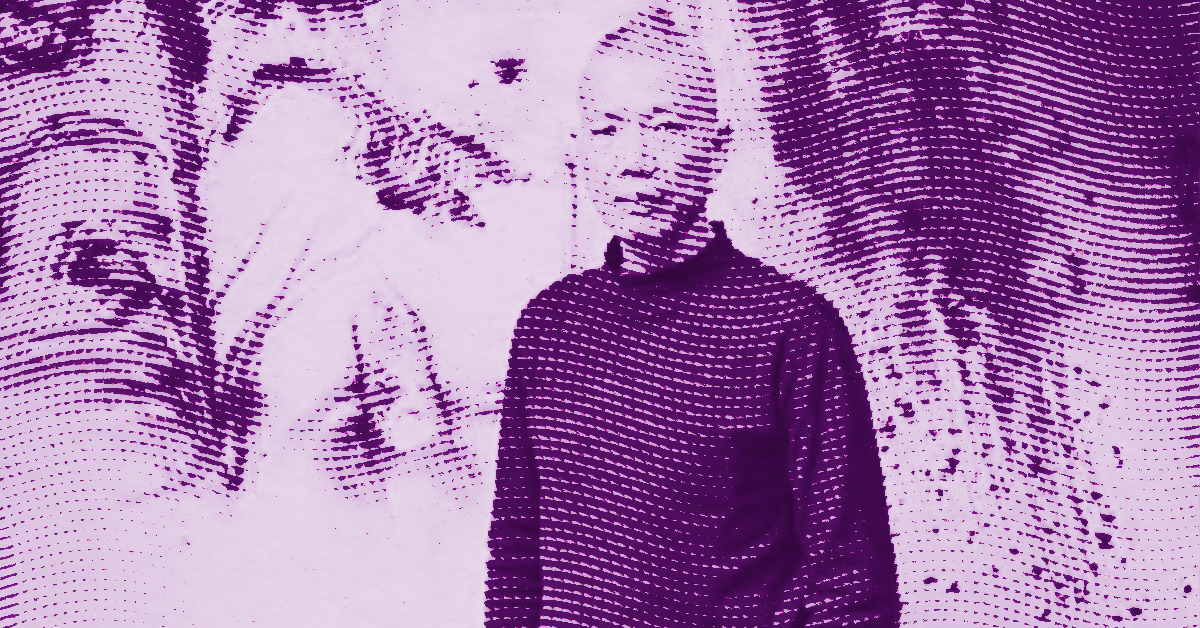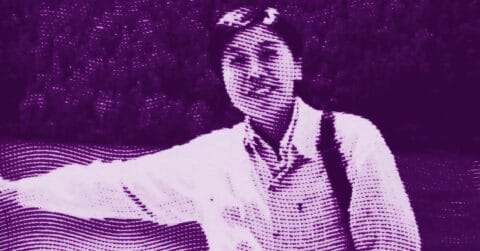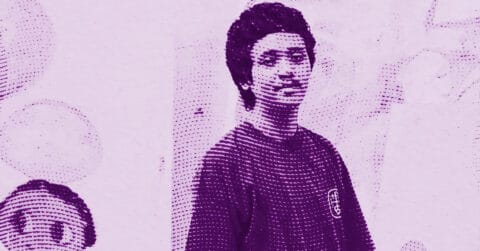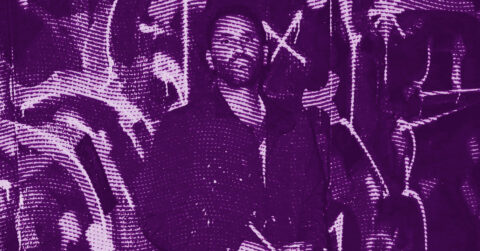Listen to me carefully, you bunch of snobs: we must stop viewing Cai Guo-Qiang merely as a Chinese pyrotechnician and finally recognize what he truly is. A man who understood that contemporary art needed a silent revolution, led not with loud manifestos but with the same substance that Chinese monks of the 9th century hoped to transform into an elixir of immortality. This black powder that changed military history becomes, under his expert hands, the instrument of a poetics of the moment and the ephemeral.
Born in 1957 in Quanzhou, Fujian province, Cai Guo-Qiang is now established as one of the most unique artists of our time. His artistic practice, which mixes ancient Chinese tradition and contemporary technologies, questions our relationships with time, space, and the invisible forces that govern the universe. From his first experiments with gunpowder in the 1980s to his recent collaborations with artificial intelligence, his work traces a fascinating trajectory where destruction and creation, control and surrender meet.
The paradoxical legacy of gunpowder
Gunpowder, this Chinese invention from the 9th century born from a quest for immortality, finds its most disturbing artistic redemption in Cai Guo-Qiang. When the artist declares: “The appeal of gunpowder lies in its uncontrollable nature and unpredictability. My creations oscillate between destruction and construction, control and freedom,” he reveals the fundamental tension driving his work. This material, historically associated with war and destruction, becomes under his brush a medium of beauty and philosophical questioning.
His gunpowder drawings, made according to a meticulous protocol but always subject to the uncertainties of combustion, perfectly embody this dialectic. The artist meticulously places his powder on the canvas, positions cardboard and weights to control the explosion, then lights the fuses. What follows is partially beyond his control: variations in wind, humidity, temperature influence the final result. This element of unpredictability, far from being a flaw, constitutes the very essence of his artistic approach.
In Shadow: Pray for Protection (1985-86), Cai pays tribute to the victims of Nagasaki using precisely the raw material of their destruction. This gesture, of remarkable conceptual boldness, transforms the instrument of death into a medium of memory and compassion. The gunpowder, mixed with melted wax, draws the ghostly silhouettes of the victims, creating an image of striking emotional power. This work masterfully illustrates the artist’s ability to turn violence into beauty, to make the instrument of destruction a tool of reconciliation.
Psychoanalysis of the explosion: The unconscious and the drive
The work of Cai Guo-Qiang invites a particularly fruitful psychoanalytic reading, especially in its complex relationship to the drive of destruction and the mechanisms of sublimation. The use of gunpowder, the raw material of war and destruction, reveals a sophisticated approach to fundamental human drives and their artistic transformation.
Freud, in Malaise in Civilization, identifies this permanent tension between destructive drives and the civilizational mechanisms of sublimation [1]. Cai Guo-Qiang’s art perfectly illustrates this process: gunpowder, diverted from its original destructive function, becomes the instrument of an artistic creation that precisely questions this original violence. This sublimation is not a simple displacement but a qualitative transformation that reveals the deepest aspects of the human condition.
The artist himself, who describes himself as “a rational person, but also full of contradictions,” reveals in this self-definition the ambivalent structure of his creative process. This assumed contradiction between rationality and spontaneity, control and surrender, evokes the defense mechanisms described by psychoanalysis. The use of gunpowder allows the artist to express destructive drives while channeling them towards a socially acceptable and aesthetically enriching creation.
The Century with Mushroom Clouds: Project for the 20th Century (1995-96) reveals this psychoanalytic dimension in a particularly evident way. By recreating the image of the atomic mushroom cloud, the quintessential symbol of mass destruction in the 20th century, Cai directly confronts humanity with its self-destructive drives. But this confrontation is accompanied by a symbolic transformation operation: the destructive mushroom is associated with lingzhi, a mushroom traditionally used in Chinese pharmacopoeia for its healing virtues.
This juxtaposition reveals an intuitive understanding of the mechanisms of psychic repair. In the face of the historical trauma represented by Hiroshima and Nagasaki, the artist offers not oblivion or denial, but a symbolic elaboration that integrates destruction and healing into a single representation. This approach evokes the processes of psychic elaboration described by psychoanalysis, where trauma is not erased but integrated into a broader narrative that allows psychic reconstruction.
The performative aspect of the explosion events also reveals a significant cathartic dimension. When Cai lights his fuses in front of an audience, he creates a moment of collective tension that culminates in the blast. This dramatic temporality, this gradual rise to the explosive climax, evokes the mechanisms of Aristotelian catharsis but in a contemporary context where the artistic spectacle replaces theatrical representation.
The audience, witness to this transformation of destructive material into ephemeral beauty, participates in a collective experience of sublimation. This participatory dimension of his art reveals a profound understanding of the social stakes of artistic creation. Art does not content itself with representing or expressing; it also transforms spectators by associating them with a process of collective sublimation.
This psychoanalytic reading also sheds light on the artist’s particular relationship with his medium. Cai describes the unpredictability of the powder as a source of excitement and anxiety: “What I really love about my fireworks are the explosions, with their abstract energy, their unexpected, uncontrollable, and disturbing nature.” This ambivalence reveals a consciously masochistic relationship to the creative process, where the artist deliberately seeks loss of control.
This search for the uncontrollable evokes the mechanisms of artistic creation as described by psychoanalysis: the emergence of the work supposes a certain relinquishment by the artist, an acceptance of forces beyond him. For Cai, this dimension is literally staged: the explosion partially escapes his control, producing effects he had not entirely anticipated.
This aesthetic of surprise and controlled accident reveals a sophisticated understanding of the unconscious mechanisms of creation. Like the analyst who interprets slips of the tongue and free associations, Cai reads in the combustion accidents signs of an artistic truth that surpasses his conscious intentions.
The recent evolution of his work towards artificial intelligence extends this reflection on the unconscious and creation. His model cAI, developed from his works and interests, functions as an extension of his psychic apparatus. This artificial “intelligence,” fed by his past productions, generates new creative proposals that sometimes surprise the artist himself.
This collaboration with the machine reveals a new modality of creative relinquishment. Where the powder introduced material accidents, AI offers unexpected conceptual variations. This technological evolution of his art maintains the dimension of unpredictability that characterizes his approach while extending it into the realm of conceptual elaboration.
The psychoanalytic dimension of Cai Guo-Qiang’s work ultimately reveals a very contemporary approach to the challenges of artistic creation. Facing a world marked by violence and uncertainty, his art proposes modes of sublimation that symbolically process collective traumas. This therapeutic function of art, without being explicitly claimed, constitutes one of the deepest and most necessary aspects of his work.
Artificial intelligence: New companion on the journey
Cai Guo-Qiang’s recent foray into the world of artificial intelligence does not constitute a break but rather a logical extension of his ongoing search for the uncontrollable and the unpredictable. Since 2017, he has been developing his model cAI, an acronym cleverly blending “AI” (artificial intelligence) and “Cai” (his name), creating a hybrid entity that functions as his digital double.
This human-machine collaboration reveals a remarkably lucid approach to the contemporary stakes of artistic creation. When the artist states: “Artificial intelligence symbolizes the unknown and invisible world. Our fervor for it, or our devout faith in it, signals a new spiritual journey for a society moving away from gods and spirituality like a lost lamb,” he reveals a profound understanding of ongoing anthropological mutations.
The cAI model does not merely reproduce or imitate the artist’s style. Fed by his works, archives, and interests, it develops distinct “personas” capable of debating among themselves. This multiplication of creative voices evokes the literary experiments of the modern era, where the single author gives way to a polyphony of perspectives.
In The Annunciation of cAI (2023), artificial intelligence does not just generate images; it directly collaborates in the making of the artwork by piloting a mechanical arm that executes the drawing with powder. This hybridization between algorithmic design and pyrotechnic execution reveals a sophisticated approach to the human-machine creative collaboration.
The use of AI in Resurrection: Proposal for the 2024 Paris Olympics perfectly illustrates this new creative modality. After the initial project could not be physically realized, cAI enabled the creation of an animated version that brings the artwork to life in the digital space. This digital “resurrection” of an unexecuted project questions traditional notions of existence and realization of the artwork.
This technological evolution of his art paradoxically maintains the unpredictability dimension that has characterized his approach from the beginning. Like gunpowder, artificial intelligence introduces elements of surprise and creative accident. The artist does not have total control over the proposals generated by cAI, creating a new form of creative “dialogue”.
This approach reveals a remarkable conceptual maturity in the face of contemporary issues of art and technology. Where many artists approach AI as a simple production tool, Cai makes it a true creative partner, an extension of his psychic apparatus that allows him to explore new conceptual territories.
An art of reconciliation
At the end of this journey through Cai Guo-Qiang’s universe, one fact stands out: we are facing an artist who has achieved the feat of reconciling opposites without diluting them. Tradition and modernity, East and West, destruction and creation, control and chance, material and spiritual: all these polarities find in his work not an easy synthesis but a dynamic and fertile coexistence.
This capacity for reconciliation reveals a rare artistic wisdom in our time of radicalization of positions. In a world marked by identity fractures and dogmatic oppositions, Cai’s art offers an alternative path based on the recognition of complexity and ambivalence. His personal journey, from China to Japan and then to the United States, led him to develop a transcultural approach that refuses reductive identity assignments.
This reconciliatory dimension of his art finds its most beautiful expression in his relationship to Chinese cultural heritage. Far from rejecting this heritage in the name of modernity or locking himself in it out of nostalgia, he transforms and updates it without betraying it. His references to feng shui, traditional Chinese medicine, ancestral painting techniques, never fall into folklorism but into a creative reinterpretation that reveals their contemporary relevance.
This approach reveals a remarkable cultural maturity that should inspire all creators faced with the question of heritage and innovation. Cai demonstrates that it is possible to be deeply rooted in a particular tradition while speaking a universally understandable language. This universality does not come from flattening differences but from a deepening that reveals what is most deeply human in each culture.
His art also reveals a renewed conception of the relationship between art and society. His collaborations with local communities, notably in Iwaki, Japan, demonstrate a desire to make art a catalyst for social connection rather than an object of distanced contemplation. This participatory dimension of his work reveals a profound understanding of the democratic issues of contemporary art.
In the face of the environmental and social challenges of our time, the work of Cai Guo-Qiang proposes modes of artistic action that combine symbolic effectiveness and aesthetic relevance. His recent works on ecological issues, such as The Ninth Wave (2014), reveal an artist aware of his social responsibilities without sacrificing the poetic dimension of his work.
This ability to maintain the tension between commitment and aesthetic autonomy constitutes one of the most valuable aspects of his art. At a time when art often oscillates between disembodied aestheticism and simplistic activism, Cai proposes a third way that fully embraces the political stakes of creation while preserving its artistic specificity.
His recent evolution towards artificial intelligence also reveals a remarkable adaptability to contemporary technological changes. Rather than undergoing these transformations or rejecting them on principle, he integrates them into his artistic approach by revealing their creative potentials and anthropological stakes.
This openness to technological innovation, combined with his grounding in Chinese tradition, makes Cai Guo-Qiang an artist particularly suited to the challenges of our time. His art reveals that it is possible to navigate contemporary complexity without losing one’s bearings or giving up one’s uniqueness.
Cai Guo-Qiang’s work ultimately constitutes an exemplary testimony of what art can be in a globalized world: a language that transcends borders without denying differences, a practice that questions the present without breaking with the past, a quest that embraces innovation without sacrificing depth. In an era often marked by fragmentation and opposition, his art outlines the contours of a possible reconciliation between all dimensions of human experience.
This uncompromising capacity for reconciliation may be the most precious lesson of his artistic journey. It reveals that it is possible to create art that is both demanding and accessible, deeply rooted and universally understandable, technologically innovative and spiritually nourished. In these times of uncertainty and division, such an artistic proposition is not only welcome: it is necessary.
- Freud, Sigmund. Civilization and Its Discontents, Paris, PUF, 1995.
















